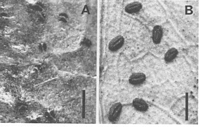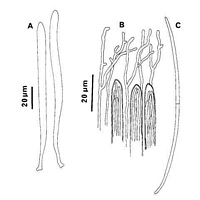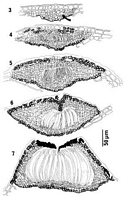|
 Terriera minor Terriera minor
SynonymsLophodermium multimatricum
Lophodermium minor
Clithris minor
BiostatusPresent in region - Indigenous. Non endemic
Images (click to enlarge)
Caption: Fig 1 Lophodermium multimatricum . Macroscopic appearance of ascocarps. A. Immature
ascocarps. B. Mature ascocarps. (bar scale = l mm). | 
Caption: Fig 2 Lophodermium multimatricum (PDD 46125). A. Asci. B. Apex of asci and paraphyses.
C. Released ascospore. | 
Caption: Fig 3-7 Lophodermium multimatricum (PDD 46127). Vertical median transverse sections of
ascocarps at different stages of development. All at the same scale. See text for details. |
Article: Johnston, P.R. (1988). An undescribed pattern of ascocarp development in some non-coniferous Lophodermium species. Mycotaxon 31(2): 383-394.
Description: Ascocarps forming on fallen leaves, in discrete groups within pale yellowish areas, or in some collections in undifferentiated areas. Not associated with zone lines or with anamorph pycnidia. In surface view immature, unopened ascocarps appear macroscopically as two blackened areas separated by a broad, pale longitudinal zone. In some collections the paler zone is less defined, and immature ascocarps appear as a single blackened area more or less elliptical in outline, with a narrow paler zone extending longitudinally along the ascocarp. Mature, opened ascocarps 0.3-0.8 (-2.0) x 0.2-0.3 mm, walls black, the ascocarp raising the host surface so that the wall becomes steeply angled to the surrounding leaf surface. Ascocarps developing a distinctive, black, flattened area adjacent to both sides of the elongate, slit-like opening. Lip cells absent.
Ascocarps subepidermal to intraepidermal. In vertical section in Immature ascocarps there are three distinct layers of tissue surrounding the developing hymenium, termed here an upper wall layer, a lower wall layer, and an inner layer. The separate upper and lower wall layers both comprising dark brown, thick-walled cells. The upper wall 10-15 µm wide, the lower wall up to about 5 µm. Between the upper and lower walls is the third, inner layer, comprising hyaline, thin-walled, cylindrical cells arranged in vertical rows. The hymenium develops within the inner layer following a breakdown of some of the vertically arranged cells near the centre of the ascocarp. In mature ascocarps the upper wall is up to 20 µm wide. There is a narrow extension to the upper wall bordering the ascocarp opening, and this covers the top of the hymenium. It consists of very dark tissue, and is oriented at right angles to the rest of the upper wall.
Paraphyses 1-2 µm diam., unswollen, branching 2-3 times near apex, extending 20-30 µm beyond asci. Asci 95-130(-150) x 6-8 µm, cylindric, tapering to rounded apex, wall not thickened at apex, 8-spored. Ascospores 75-100 x 1.5-2 µm, tapering slightly to both ends, 0-1 septate, surrounded by a narrow gelatinous sheath.
CHARACTERISTICS IN CULTURE: Ascospores from seven collections germinated on agar within 2-4 days. The appearance in culture was variable. in most isolates on oatmeal agar, colonies were 50-70 mm diam. after 3 weeks, aerial mycelium was cottony, white to pale grey, agar surface was not discoloured. Black-walled, more or less globose bodies developed near centre of colonies, mostly remaining sterile but in one collection (PDD 43259) containing immature asci. In isolates from two collections (PDD 43038 and PDD 43036) aerial mycelium was sparse, white, stringy, agar surface was brown to vinaceous-brown, with globose, black-walled pycnidia with yellowish conidial ooze present on agar surface. Pycnidia were up to 250 µm diam., wall up to 30 µm wide, pseudoparenchymatous, outermost 2-3 layers of cells with dark brown, thickened walls, otherwise of thin-walled, hyaline cells. Conidiogenous layer lined whole of the single, convoluted locule. Conidiogenous cells 10-22 x 2.5-4 µm, discrete, more or less flask-shaped, sympodial, often with two conidia held at apex. Conidia 3-7 x 0.8-1.2 µm, cylindric with rounded ends, nonseptate, hyaline.
Habitat: Fallen leaves of Beilschmiedia tawa, Cordyline spp., Clusia sp., Dendrobium sp.,
Dracophyllum pyrimidale, Elaeocarpus hookerianus, Freycinetia baueriana ssp. banksii,
Gahnia sp., Gaultheria spp., Hoheria sp., Knightia excelsa, Leptospermum sp., Metrosideros
fulgens, Nestegis lanceolata, Nothofagus dombeyi, N. fusca, N. menzlesii, N. truncata,
Phormium sp., Pseudopanax spp., Rhopalostylis sapida, Ripogonum scandens, Rubus
cissoides, Weinmannia racemosa.
Distribution: All parts of New Zealand, also from Chile, Venezuela.
Notes: ETYMOLOGY: multi- = many, -matricum = matrix, host; refers to large number of plant
species on which this fungus is found.
NOTES: Two features distinguish L. multimatricum from other Lophodermium species found
in New Zealand:
1. a layer of cylindrical cells arranged in vertical rows between the wall layers and the
hymenium; and
2. ascomata which lack lip cells but which at maturity have a black, flattened area
adjacent to both sides of the ascocarp opening. In vertical section this flattened area is seen as
a distinct, narrow extension to the upper wall, stretching across the top of the hymenium.
Several other Lophodermium species, described from other parts of the world on
various angiosperm hosts, also have these two distinctive features (see below). L.
multimatricum is distinguished from these species by the shape of the paraphysis apex, by the
width and shape of the ascus apex, and by the presence or absence of anamorph pycnidia.
Article: Johnston, P.R. (1989). Rhytismataceae in New Zealand. 2. The genus Lophodermium on indigenous plants. New Zealand Journal of Botany 27(2): 243-274 (http://www.rsnz.org/publish/abstracts.php).
Habitat: Fallen leaves of Astelia sp., Beilschmiedia tawa, Cordyline spp., Dendrobium sp.,
Dracophyllum pyramidale, D. longifolium, Elaeocarpus hookerianus, Freycinetia baueriana
ssp. banksii, Gahnia sp., Gaultheria spp., Hoheria sp., Knightia excelsa, Leptospermum sp.,
Metrosideros fulgens, Nestegis lanceolata, Nothofagus fusca, N. menziesii, N. truncata,
Phormium sp., Pseudopanax spp., Rhopalostylis sapida, Ripogonum scandens, Rubus
cissoides, Weinmannia racemosa.
Distribution: Northland, Auckland, Coromandel, Waikato, Bay of Plenty, Gisborne,
Taupo, Wanganui, Nelson, Buller, Westland, North Canterbury, Dunedin. Also known from
Chile and Venezuela.
Notes: For description, illustrations, and characteristics in culture see Johnston (1988a).
This is the most common species of Lophodermium found on native plants in New
Zealand. Both macroscopic and microscopic features distinguish this species, L. asteliae, L.
breve, and L. kaikawakae from other Lophodermium species found in New Zealand. All four
species have a layer of cylindrical cells arranged in vertical rows surrounding the hymenium.
This layer can be seen in vertical sections at all stages of ascocarp maturity. Macroscopically,
the immature ascocarps often have a well developed paler zone along the future line of
opening, and the mature ascocarps have a distinctive black, flattened area adjacent to both
sides of the ascocarp opening.
|